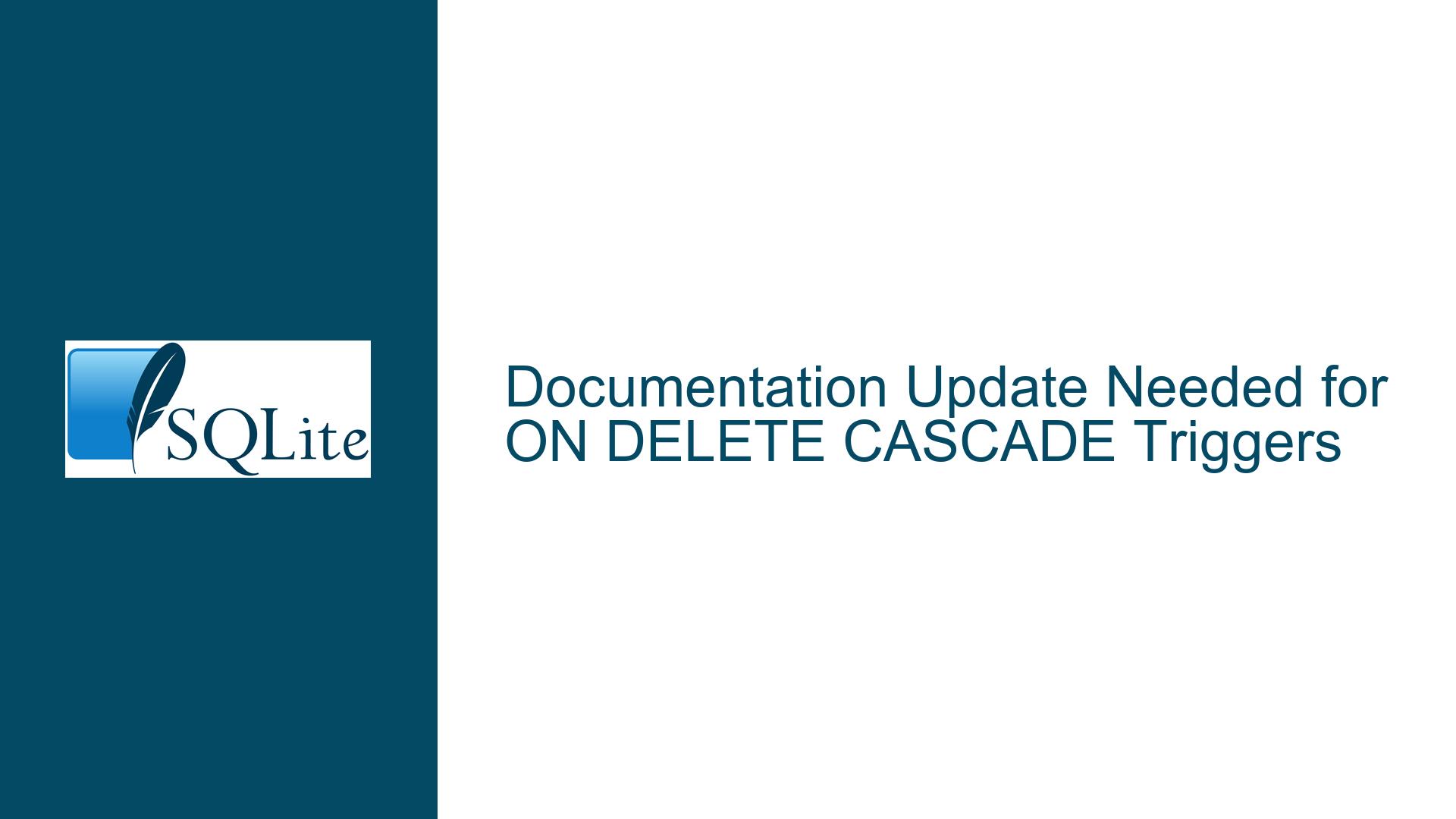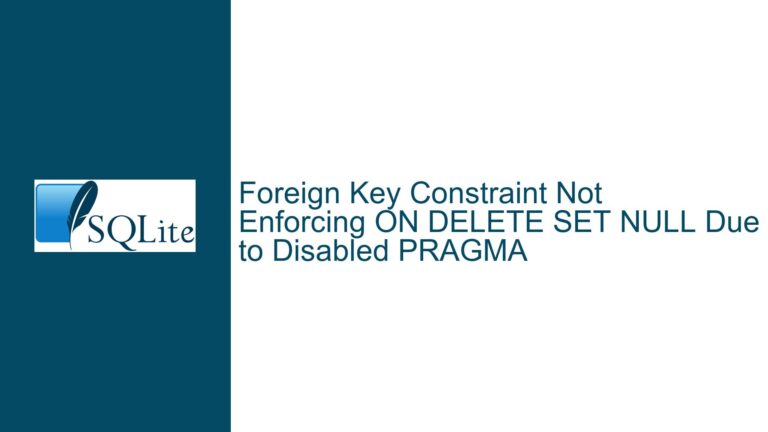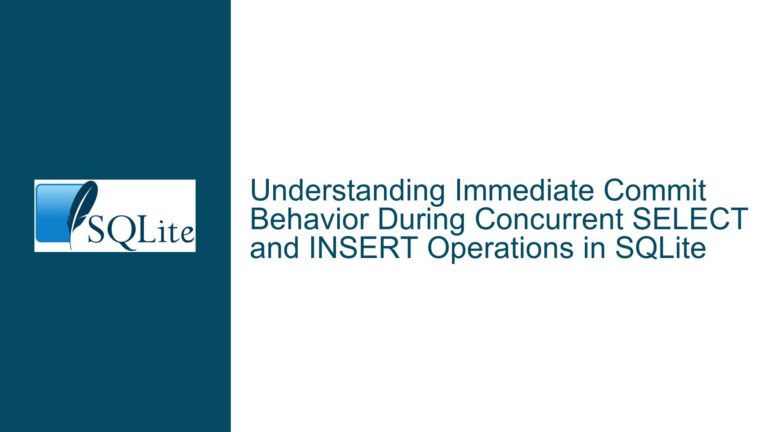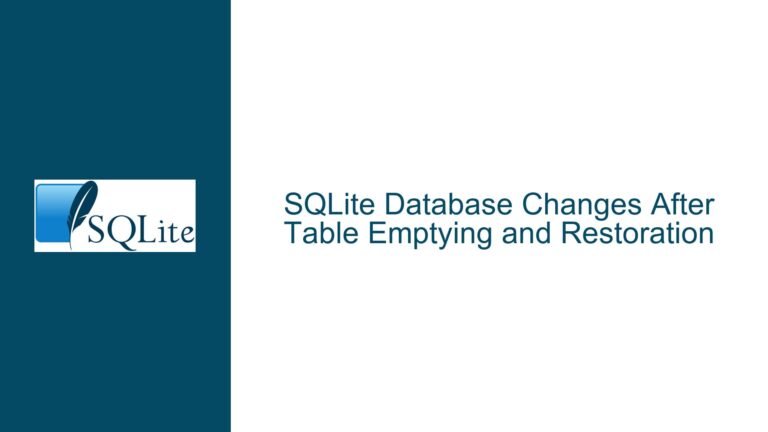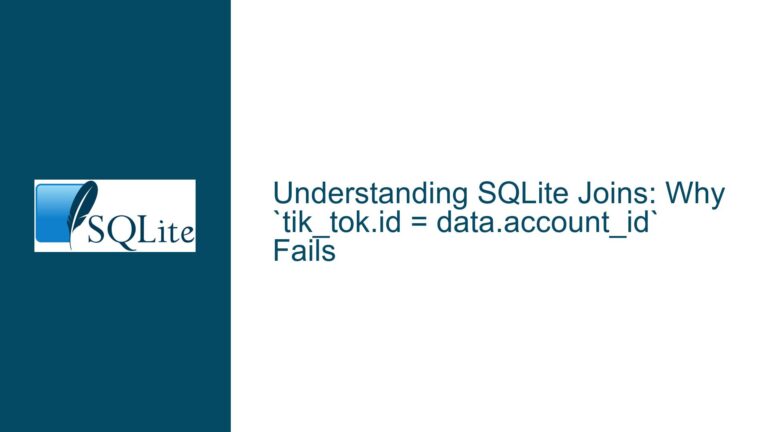Documentation Update Needed for ON DELETE CASCADE Triggers
Issue with ON DELETE CASCADE Behavior in Triggers
In SQLite, the implementation of triggers, particularly those involving cascade deletes, can lead to unexpected behaviors that developers must be aware of. A user in the SQLite forum recently encountered a bug related to this aspect of trigger functionality. The core issue arises when a parent record is deleted before its child records, which are also set to be deleted through cascading. This sequence can create a situation where the parent record no longer exists by the time the child’s DELETE triggers execute.
This behavior is crucial for developers to understand because it can lead to data integrity issues and unexpected application behavior. When a DELETE operation is performed on a parent table that has foreign key constraints with ON DELETE CASCADE, SQLite first removes the parent record. However, if there are associated child records that have their own DELETE triggers defined, those triggers may attempt to reference the now-nonexistent parent record during their execution. This scenario can result in errors or unintended data states, complicating debugging and data management efforts.
The forum discussion suggests that the documentation for the CREATE TRIGGER command should include a cautionary note regarding this behavior. Such an addition would serve as a preventative measure, helping developers avoid similar pitfalls when designing their database schemas and implementing triggers.
Understanding this issue requires a deep dive into how SQLite handles foreign key constraints and cascading deletes in conjunction with triggers. This knowledge is essential for anyone involved in database design or maintenance, as it directly impacts data integrity and application stability.
Key Concepts Involved:
- Foreign Key Constraints: These ensure that relationships between tables remain consistent. When a record in a parent table is deleted, all related records in child tables are also deleted if ON DELETE CASCADE is specified.
- Triggers: These are special types of stored procedures that automatically execute in response to certain events on a particular table or view. In this case, DELETE triggers are executed when a deletion occurs.
- Cascading Deletes: This feature allows for automatic deletion of related records in child tables when a record in the parent table is deleted.
Implications for Developers:
- Data Integrity: The primary concern with cascading deletes and triggers is maintaining data integrity across related tables. If not handled correctly, developers may find themselves with orphaned records or incomplete data states.
- Debugging Complexity: The interaction between cascading deletes and triggers can complicate debugging efforts. When unexpected behaviors occur, tracing back through the cascade of deletions and trigger executions can be challenging.
- Documentation Awareness: Developers must be vigilant about reading and understanding documentation related to foreign keys and triggers in SQLite. A lack of awareness can lead to costly mistakes during development.
In conclusion, the issue highlighted in the forum discussion underscores the importance of understanding how ON DELETE CASCADE interacts with triggers in SQLite. By ensuring that documentation reflects these nuances, developers can better prepare themselves to handle potential pitfalls associated with cascading deletes and maintain robust database applications.
Understanding the Behavior of ON DELETE CASCADE in SQLite Triggers
The behavior of ON DELETE CASCADE in SQLite can lead to complex scenarios, especially when combined with triggers. This section delves into the various possible causes of issues that arise when using cascading deletes in conjunction with triggers, emphasizing the importance of understanding the underlying mechanics.
Cascading Deletes and Referential Integrity
Cascading deletes are designed to maintain referential integrity within a relational database. When a record in a parent table is deleted, all related records in child tables are also deleted automatically if they are linked through foreign key constraints with the ON DELETE CASCADE option. This feature is essential for ensuring that no orphaned records remain in the database, which could lead to inconsistencies and data integrity issues.
However, the implementation of cascading deletes can introduce complications, particularly when triggers are involved. Triggers are special procedures that execute automatically in response to certain events on a table, such as INSERT, UPDATE, or DELETE operations. When a DELETE operation occurs on a parent table, the cascading action will trigger all associated child deletions, which may also invoke their own triggers.
Sequence of Operations and Timing Issues
The sequence in which operations occur during a cascading delete can lead to timing issues. When a parent record is deleted, SQLite first removes that record before executing any associated triggers on child records. If those child records have their own DELETE triggers defined, they may attempt to reference the now-deleted parent record during their execution. This can result in errors or unexpected behavior since the parent no longer exists at the time the child’s trigger runs.
For instance, consider a scenario where a parent table has a foreign key constraint set to ON DELETE CASCADE, and there are multiple levels of child tables dependent on this parent. If a DELETE operation is performed on the parent table:
- The parent record is deleted.
- All child records linked to this parent through foreign keys are deleted.
- If any of these child records have their own DELETE triggers that reference the parent, those triggers will fail because the parent record is no longer available.
This sequence highlights the potential pitfalls of relying solely on cascading deletes without considering how triggers might interact with them.
Complexity in Trigger Logic
The logic defined within triggers can also complicate matters. Developers often implement complex business logic within triggers to handle related data updates or deletions. However, when these triggers are executed as part of a cascading delete operation, they may not behave as expected due to missing references or altered data states.
For example, if a trigger is designed to perform additional cleanup actions when a record is deleted from a child table but relies on values from its parent table, it may encounter issues if it assumes that the parent still exists during execution. This can lead to unintended consequences such as incomplete deletions or errors being thrown.
Potential Causes of Issues
Timing Conflicts: The order of operations during cascading deletes can lead to situations where dependent triggers fail due to missing references.
Complex Trigger Logic: Triggers that rely on data from other tables may not execute correctly if those tables have already undergone deletions due to cascading actions.
Lack of Documentation: Insufficient documentation regarding how ON DELETE CASCADE interacts with triggers can lead developers to misunderstand their behavior, resulting in poorly designed database schemas.
Nested Triggers: In some database systems (though not directly applicable to SQLite), nested triggers can complicate execution flows and create additional challenges when managing cascading deletes.
Error Handling: Without proper error handling mechanisms in place within triggers, unexpected failures during cascading operations can go unnoticed and lead to data integrity problems.
Conclusion
Understanding the behavior of ON DELETE CASCADE in conjunction with triggers is crucial for maintaining data integrity and ensuring that applications function as intended. Developers must carefully consider how cascading deletes interact with trigger logic and be mindful of potential timing conflicts and complexities that may arise during execution. By addressing these issues proactively through proper schema design and thorough documentation, developers can mitigate risks associated with cascading deletes and maintain robust database applications.
Steps to Troubleshoot ON DELETE CASCADE Issues with Triggers
The implementation of ON DELETE CASCADE in SQLite can be beneficial for maintaining referential integrity, but it can also lead to complications, especially when triggers are involved. This section outlines a structured approach to troubleshoot issues related to cascading deletes and their interaction with triggers in SQLite.
Step 1: Ensure Foreign Key Support is Enabled
The first step in troubleshooting ON DELETE CASCADE issues is to confirm that foreign key support is enabled in your SQLite database. By default, foreign key constraints are disabled in SQLite, which means that any ON DELETE CASCADE actions will not function as expected. You can enable foreign key constraints by executing the following command immediately after opening the database connection:
PRAGMA foreign_keys = ON;
This command must be run before any table creation or data manipulation commands. If you are using a framework or library to manage your SQLite database, ensure that this pragma statement is included in the initialization code.
Step 2: Verify Trigger Logic
Once foreign key support is confirmed to be enabled, the next step is to examine the logic within your triggers. Triggers should be designed to handle cascading deletes correctly without introducing errors. When defining a trigger for a DELETE operation, utilize the OLD keyword to reference the values of the deleted row. For example:
CREATE TRIGGER delete_child_records
AFTER DELETE ON parent_table
FOR EACH ROW
BEGIN
DELETE FROM child_table WHERE child_table.parent_id = OLD.id;
END;
In this example, OLD.id refers to the ID of the parent record being deleted. Ensure that all references to parent records within child triggers use the OLD keyword appropriately.
Step 3: Test Cascade Behavior
After verifying that foreign key support is enabled and trigger logic is correct, test the cascade behavior by performing a DELETE operation on the parent table. Observe whether the corresponding child records are deleted as expected. If they are not, check for any constraints or conditions that may prevent cascading deletes from occurring.
For instance, if there are additional conditions within your trigger that might restrict deletions based on certain criteria, ensure these conditions align with your intended behavior.
Step 4: Review Schema Design
Examine your database schema design to ensure that relationships between tables are correctly defined with appropriate foreign key constraints. The following table illustrates how foreign keys should be defined:
| Table Name | Foreign Key Reference | ON DELETE Action |
|---|---|---|
| parent_table | child_table.parent_id | ON DELETE CASCADE |
| child_table | grandchild_table.child_id | ON DELETE CASCADE |
Ensure that each foreign key constraint is explicitly defined with the ON DELETE CASCADE action where necessary. This will help maintain referential integrity and ensure that deletions propagate as intended.
Step 5: Check for Nested Triggers
If your database schema includes multiple levels of nested triggers, it is essential to review their interactions carefully. Nested triggers can complicate deletion sequences and may lead to unexpected behaviors if not managed correctly. Ensure that each trigger operates independently and does not interfere with others during cascading delete operations.
Step 6: Implement Error Handling
Incorporate error handling within your triggers to manage potential failures during delete operations gracefully. This can include logging errors or rolling back transactions if cascading deletes cannot be completed successfully. For example:
CREATE TRIGGER delete_with_error_handling
AFTER DELETE ON parent_table
FOR EACH ROW
BEGIN
BEGIN TRY
DELETE FROM child_table WHERE child_table.parent_id = OLD.id;
EXCEPTION WHEN OTHERS THEN
-- Handle error (e.g., log it)
END TRY;
END;
This approach ensures that any issues encountered during delete operations are documented and can be addressed without causing data integrity problems.
Step 7: Monitor for Data Integrity Issues
After implementing these troubleshooting steps, closely monitor your database for any data integrity issues resulting from cascading deletes. Regular audits of your data can help identify orphaned records or inconsistencies that may arise from improper cascading behavior.
By following these structured steps, developers can effectively troubleshoot issues related to ON DELETE CASCADE and ensure that their SQLite databases maintain referential integrity while utilizing triggers appropriately. Understanding the nuances of cascading deletes and triggers will enhance overall database management and application stability.
